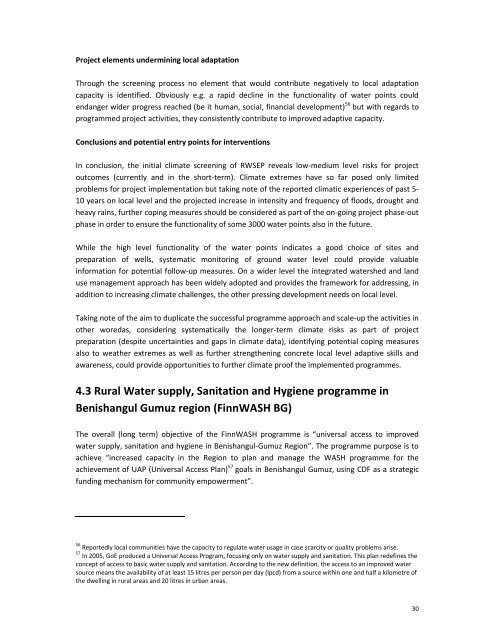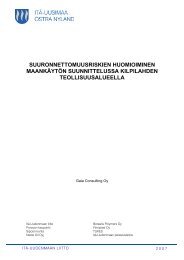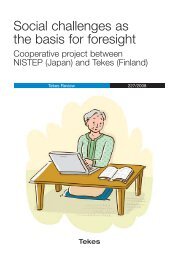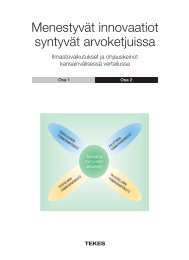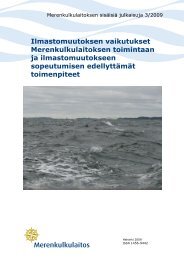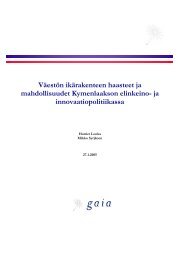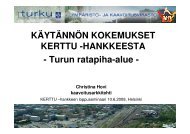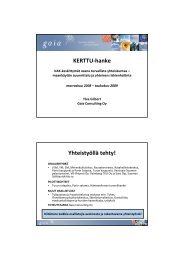Climate Risk Management in Finnish Development Cooperation - Gaia
Climate Risk Management in Finnish Development Cooperation - Gaia
Climate Risk Management in Finnish Development Cooperation - Gaia
Create successful ePaper yourself
Turn your PDF publications into a flip-book with our unique Google optimized e-Paper software.
Project elements underm<strong>in</strong><strong>in</strong>g local adaptation<br />
Through the screen<strong>in</strong>g process no element that would contribute negatively to local adaptation<br />
capacity is identified. Obviously e.g. a rapid decl<strong>in</strong>e <strong>in</strong> the functionality of water po<strong>in</strong>ts could<br />
endanger wider progress reached (be it human, social, f<strong>in</strong>ancial development) 56 but with regards to<br />
programmed project activities, they consistently contribute to improved adaptive capacity.<br />
Conclusions and potential entry po<strong>in</strong>ts for <strong>in</strong>terventions<br />
In conclusion, the <strong>in</strong>itial climate screen<strong>in</strong>g of RWSEP reveals low-medium level risks for project<br />
outcomes (currently and <strong>in</strong> the short-term). <strong>Climate</strong> extremes have so far posed only limited<br />
problems for project implementation but tak<strong>in</strong>g note of the reported climatic experiences of past 5-<br />
10 years on local level and the projected <strong>in</strong>crease <strong>in</strong> <strong>in</strong>tensity and frequency of floods, drought and<br />
heavy ra<strong>in</strong>s, further cop<strong>in</strong>g measures should be considered as part of the on-go<strong>in</strong>g project phase-out<br />
phase <strong>in</strong> order to ensure the functionality of some 3000 water po<strong>in</strong>ts also <strong>in</strong> the future.<br />
While the high level functionality of the water po<strong>in</strong>ts <strong>in</strong>dicates a good choice of sites and<br />
preparation of wells, systematic monitor<strong>in</strong>g of ground water level could provide valuable<br />
<strong>in</strong>formation for potential follow-up measures. On a wider level the <strong>in</strong>tegrated watershed and land<br />
use management approach has been widely adopted and provides the framework for address<strong>in</strong>g, <strong>in</strong><br />
addition to <strong>in</strong>creas<strong>in</strong>g climate challenges, the other press<strong>in</strong>g development needs on local level.<br />
Tak<strong>in</strong>g note of the aim to duplicate the successful programme approach and scale-up the activities <strong>in</strong><br />
other woredas, consider<strong>in</strong>g systematically the longer-term climate risks as part of project<br />
preparation (despite uncerta<strong>in</strong>ties and gaps <strong>in</strong> climate data), identify<strong>in</strong>g potential cop<strong>in</strong>g measures<br />
also to weather extremes as well as further strengthen<strong>in</strong>g concrete local level adaptive skills and<br />
awareness, could provide opportunities to further climate proof the implemented programmes.<br />
4.3 Rural Water supply, Sanitation and Hygiene programme <strong>in</strong><br />
Benishangul Gumuz region (F<strong>in</strong>nWASH BG)<br />
The overall (long term) objective of the F<strong>in</strong>nWASH programme is “universal access to improved<br />
water supply, sanitation and hygiene <strong>in</strong> Benishangul-Gumuz Region”. The programme purpose is to<br />
achieve “<strong>in</strong>creased capacity <strong>in</strong> the Region to plan and manage the WASH programme for the<br />
achievement of UAP (Universal Access Plan) 57 goals <strong>in</strong> Benishangul Gumuz, us<strong>in</strong>g CDF as a strategic<br />
fund<strong>in</strong>g mechanism for community empowerment”.<br />
56 Reportedly local communities have the capacity to regulate water usage <strong>in</strong> case scarcity or quality problems arise.<br />
57 In 2005, GoE produced a Universal Access Program, focus<strong>in</strong>g only on water supply and sanitation. This plan redef<strong>in</strong>es the<br />
concept of access to basic water supply and sanitation. Accord<strong>in</strong>g to the new def<strong>in</strong>ition, the access to an improved water<br />
source means the availability of at least 15 litres per person per day (lpcd) from a source with<strong>in</strong> one and half a kilometre of<br />
the dwell<strong>in</strong>g <strong>in</strong> rural areas and 20 litres <strong>in</strong> urban areas.<br />
30


